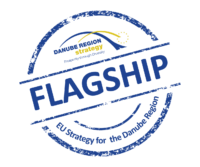Platform; ongoing
EUSDR Priority Area(s): PA 5 Environmental Risks
Nature-based solutions (NBS) for flood risk reduction are interventions inspired and supported by nature, providing cost-effective environmental, social, and economic benefits while building resilience. These solutions enhance urban and rural landscapes by integrating natural features and processes, often allowing nature to self-sustain (e.g., river restoration). In flood risk management, NBS involve managing erosion and flood risks by leveraging natural regulatory functions of catchments and coasts, promoting human well-being and biodiversity.
Recent decades have seen a push for flexible, multifunctional solutions in flood risk management, leading to the rise of NBS. These solutions mitigate flood impacts like erosion and sedimentation, reduce drought risk, and offer other benefits. NBS can be purely natural (“green”) or hybrid, combining natural and engineered elements, embodying the concept of “making more space for rivers” and necessitating basin-level flood protection planning.
To advance NBS, an online workshop in October 2022, organised by EUSDR PA 5 with the involvement of PA 4 Water Quality and PA 6 Biodiversity, showcased successful projects from 17 countries. These included initiatives like the Danube Floodplain Projects, FRAMWAT, MERLIN, Optain, and Danube4All. Key recommendations from the workshop included sub-basin level NBS design, advocating for supportive legislation, promoting case studies, and disseminating information on water retention strategies.
The Global Water Partnership (CEE) has established a mission to define, design, and launch a community of practice (CoP) related to NBS in 2022. The community will build on the GWP Toolbox – IWRM action hub, which GWP has recently developed and launched.
The Interreg Europe NBS4LOCAL project, launched in March 2023, aims to integrate NBS into policy instruments, supporting local authorities with regulatory measures and resource allocation. Additionally, a study on advancing NBS in hillside water management and the establishment of the Nature-based Solutions Hub (TeAM HUb) in Hungary highlights ongoing efforts.
EUSDR PA 5’s platform on NBS for flood risk reduction provides examples and policy recommendations across the Danube Region. Effective flood management is crucial for protecting communities and assets. NBS, alongside traditional engineering (“gray infrastructure”), offers sustainable alternatives by utilising natural processes for flood risk reduction and improving water quality.
Objectives:
- Providing practical examples and evidence of effective NBS projects that enhance flood risk management and climate resilience.
- Promoting knowledge exchange and capacity building through workshops and collaborative projects.
- Supporting policy recommendations and legislative changes that facilitate the adoption of NBS, contributing to both flood risk management and climate change adaptation goals.
Thus, the initiatives on NBS for flood risk reduction in the Danube Region are making significant strides toward achieving the specified actions and targets, ensuring a comprehensive and resilient approach to environmental and flood risk management.
Need and (expected) impact: The Danube Region faces significant flood risks due to diverse topography, extensive river networks, and climate variability. Traditional “gray” infrastructure for flood management is costly, environmentally damaging, and insufficient for addressing increasing climate challenges.
Relevance and Added Value
- Supports EUSDR PA 5 goals (Actions and Targets as defined in the EUSDR Action Plan), particularly in Environmental Risks and Water Quality and Biodiversity (PILAR)
- Ecological and Social Benefits: Enhances biodiversity, improves water quality, and provides recreational spaces.
- Economic Efficiency: Offers long-term cost savings and valuable ecosystem services.
- Comprehensive Flood Management: Integrates NBS into basin-level strategies, preventing downstream effects.
Impact on the Danube Region
- Enhanced Resilience: Improved flood and drought resilience through natural floodplain and wetland restoration.
- Climate Adaptation: Support for regional adaptation to climate change impacts by utilising natural processes for flood management.
Macro-regional dimension: All Danube Region countries, and in the frame of the LIFE SANDBOIL project another macro-regional strategy is involved, since Italy (Po-river basin) is the lead partner.
Stakeholders involved: Involved stakeholders include Hungarian Ministries (Ministry of Public Administration and Regional Development, Ministry of Interior of Hungary, Ministry of Foreign Affairs and Trade of Hungary), Water Authorities, Municipalities, Universities, and NGOs like ICPDR, GWP (CEE) and WWF.
Budget and Funding: Funding sources encompass CBC Programmes, Interreg DRP, Horizon Europe, and LIFE programmes.
Further information: https://environmentalrisks.danube-region.eu/
Contact: Mr László Balatonyi (Ph.D.), Priority Area Coordinator, PA 5, Ministry of Foreign Affairs and Trade Hungary,

>> Download Certificate 2022 <<

